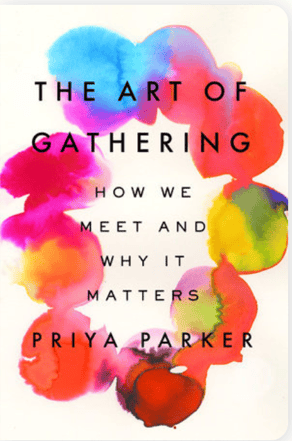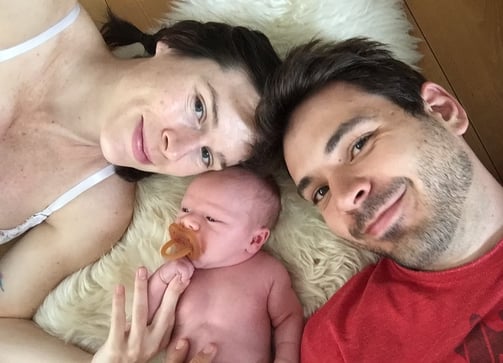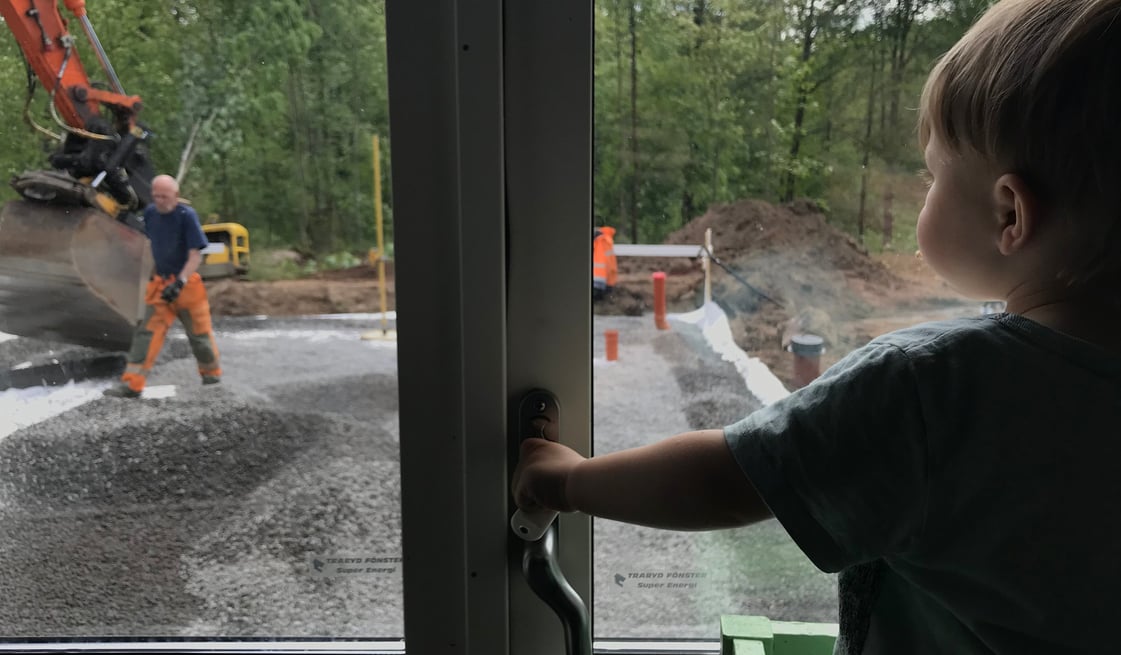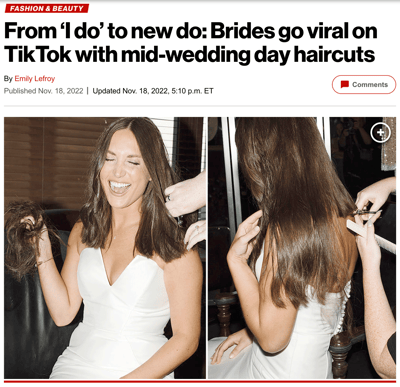Why I'll never have a wedding
The winding road to our 10-year anniversary party
Rachel Hahn
10 min read
The centre of attention is my happy place. As evidence, I present my nascent career as a radio host, years parading around stages donning a spray tan and bedazzled bikini, plus inflicting my Grade 3 class to myriad performances of a serial dramedy featuring a mentally unbalanced bird woman. Bless you, Mr. Greenwood, for what can only be understood in hindsight as god-like patience and encouragement.
Why is this relevant? Because, it seems to me, the modern wedding is more about being the centre of attention than it is getting ready to share your life with someone. Take one of the latest nuptial trends: in addition to a wardrobe change from ceremonial gown to reception outfit, brides are now undergoing a dramatic haircut and re-styling. From long flowing locks to edgy bob, the dramatic haircut isn’t just for the post break-up babe anymore. Sure, the scissor spurred transformation can stand as metaphor – from blushing maid to married woman – but don’t try to tell me it’s not about the reaction from the crowd (or the ‘gram).
New York Post, Published Nov. 18, 2022
Years ago, while working as lead creative for a company’s annual multi-day conference, I read Priya Parker’s “The Art of Gathering”. A thoughtful reflection on hosting events, one of the book’s first anecdotes focuses on Priya’s baby shower – a boilerplate affair exclusively for her and her female friends. In retrospect, she regrets the arrangement because this was a monumental life transition for both her and her husband, and the two had agreed to a collaborative parenting approach. Why then – she reasonably asked – was the baby shower all about her becoming a mother? Her answer: because that’s the template we have.
Now, I’m not here to pass aspersions. I repeat: bedazzled bikini. I just want us to be honest about our intentions when it comes to the hullabaloo around “I do”. Because that honesty can lead to creating even more meaningful and satisfying experiences for everyone involved.
Templates are great. They keep you from having to start from scratch, which can be particularly helpful if you’re trying to do something you’ve never done before (like plan a wedding). But sometimes, when things are relatively new to society (like the increasing number of people living together before marriage) there’s no appropriate template for the job. That’s when we start retrofitting existing templates, warping them to our specific needs, or creating something entirely different.
Socio-cultural templates, such as the one Priya’s baby shower used, can go by another name: traditions. And as much as traditions can serve us, they can also constrict us.
Now, I’m not a nostalgia-immune tradition-trashing monster. I love a good socio-cultural template. Give me the invigorating scent of a fresh cut pine in the dead of winter! Dress me up and send me door to door collecting goodies on a dark autumn eve! Any anthropologist worth their weight in doctoral degrees will tell you traditions are integral to the human experience.
The catch is that traditions, by their nature, are resistant to evolution and adaptation – the transformation of society and culture will consistently outpace them. That’s how we end up having fathers walking daughters down the aisle even though it’s been about a century since women gained legally mandated equality to men in Canada and much of the western world.[1]


Do I think you’re a patriarchy-loving, subservient, brainwashed person if you have your beloved dad ceremonially escort you to the side of your future life partner? Yes.
Kidding!
Absolutely not. It’s just an example of the disconnect between the origins of traditions and our modern world.
What’s the origin of the wedding anyway? Now would be an apt moment to point out that a wedding and a marriage are not the same thing. Marriage is an institution (oooh, romantic) that joins two genetically unrelated (or unrelated enough) people to create a new household. And yea, for most of human history this wasn’t associated with romantic love in the slightest. The whole love-marriage thing became more and more popular as women progressively gained personhood and rights in society (read Marilyn Yalom’s “A History of the Wife” to fall down that rabbit hole).
Experts generally agree that marriage was a result of the switch from nomadic hunter gatherer societies to agrarian ones about 20,000 years ago. Marriage was a very practical arrangement to support a new lifestyle where there was suddenly a static household (and its inhabitants) to maintain. The word “husband” hints at this. The origins is Old Norse, with “hús” meaning “house” and “band” coming from “bóndi” for the one who occupies and/or tills the earth. I now pronounce you house owner/worker and woman[2].
Weddings, on the other hand, are the ceremonies that mark the occasion of entering into the institution of marriage. One can assume, due to the human predilection to party, that weddings have existed for as long as marriage has. But the first known documentation of a wedding dates to 2350 B.C. Aside from a good party, weddings are generally events that help prepare the couple for their new life together. Cue the registry with its array of kitchen appliances, tableware, and essential monogrammed towels.
But what does a wedding look like when there isn’t a “new” life to start together because the couple is already living together?
In Canada, while the wedding industry is making a post-pandemic recovery, marriage rates continue to decline. The number of common-law couples has more than quadrupled between 1988 and 2021 and now about 1 out of every 4 legally bound Canadian pairs are of common law status.
For all intents and purposes aside from legal, I’m married. I met Björn on the streets of Amsterdam in 2014. A few months later we were living together in a minuscule apartment on the southern tip of Sweden. From there, well, you know.
In Sweden, Björn and I are far from unique. Nearly 2 million Swedes (that’s around 18% of the population) live with a romantic partner. We’re sambos – Swedish for common law, a shortening of “sammanboende” meaning “living together”.
And though Sweden is renowned as a progressive land, it’s certainly not an outlier when it comes to global coupledom trends. Today, nearly 90% of the world’s population live in countries with falling marriage rates. And where marriage rates are falling, common law relationships are becoming, well, more common.
There are many theories as to the driving forces behind these global trends. More and more people put off marriage in order to focus on careers, or build a nest egg, or travel, or, or, or. The amount of socially acceptable life paths is ever-expanding and with it, the societal pressures around traditional coupledom wanes. More than half of Canadians say legal marriage isn’t important for those planning to be together long-term.
As much as there’s no single smoking gun behind these nuptial trends, as I was researching this essay, one factor was consistently presented as a major culprit for wedding-avoidance. One which only strengthened post-Covid. What do people always tell the would-be detective on the hunt for the guilty party? Follow the money.
As the cost of living has been rising, so has the average price tag for a wedding (currently around $25,000). Take into account growing student debts, job insecurity and a tumultuous economic climate and you’ll find many people aren’t so keen (or able) to put up the cash for a big celebration. When you pair that financial constraint with a more relaxed societal view on unwed coupledom, it starts to become easier for people to rearrange their money-spending priorities.
Björn and I are boringly unexceptional in our coupledom. Like many people do nowadays, we met well into our adult lives, at a time when we were both secure in our careers, living independently, and generally self-sufficient. I.e., Björn and I would be financing any and all of our life events moving forward, including a potential wedding[3]. So, the question became one of priorities.
Did we ever want to get married? Sure. We’re even officially engaged… twice (because I said you have to re-up that kind of commitment every few years). But we also wanted to live in a space that was bigger than our city-centre bachelor pad, particularly considering we were both working from home (pre-Covid, I know – we’re trend setters). The first thing we invested our savings in was a 2-bedroom condo. We became homeowners and we were pretty happy with that.
So happy, in fact, that we decided our next move was going to be parenthood. Though many people have entirely wonderful pregnancies, I was not one of them. This didn’t leave me in much of a party mood any given day of the week, ruling out baby-bump bridehood. Our wedding plans were pushed further down the road.
With a baby on the way, we realized we didn’t want to live in the city centre (not so trendsetting after all, I suppose). We started looking for a new home. When we found our diamond in the rough, it became financial priority #1. In addition to the initial purchase, there were much needed renovations to fund (the home inspector said we could totally use the shower if we didn’t mind rotting the home’s foundation and framing). Once we made the space liveable, we expanded it (cue “ca-ching” sound effect).
Just as we got the town’s approval to move into our newly renovated and extended home, it was no longer feasible to host a wedding because the world was being gripped by a pandemic. And in truth, we needed time to refill our coffers before taking on a new major expense.


Engagement #1 - A hiking path on the coast of Ireland, 2017


On the floor of our first home, 2017
Throughout these years I’ve written numerous guest lists for our fictional wedding. Each time made my chest tighten as I spiralled into various states of anxiety. I tended to start with essential family, then of course reciprocal invites for those who have included us in their weddings. Then friends, extended family, colleagues? Did I need bridesmaids as a nearly 40-year-old?
As the list grew, I wondered where to draw the line. Whose feelings might get hurt for being excluded? Were Björn and I equally represented in the overall headcount? Should I include estranged family members? Why do I have so many cousins!?
Guest lists are their own beast – notorious for instigating panic attacks, family feuds and general meltdowns. I wanted to feel excited about everyone who’d come to our wedding, not anxious, not strategic, not concerned about potential conflicts and stressed over mounting costs. Luckily, one of my greatest defense mechanisms is avoidance. And thus, a guest list has never been finalized.
At some point in all of this avoidance, I started to wonder why we should have a wedding at all. What did I want to achieve with one? Here I am, sitting at my dining table in my home that was renovated and built with the help of my family and friends. We have art on the wall, food in the fridge, cutlery in the drawers and multiple nooks full of towels (albeit initial-less ones). Our children have received ample hand-me-downs and care in the form of sleepovers, babysitting, outings and various expressions of love.
We’ve been set up for our life together. We’re living it. Looking out from our perch in what’s been termed post-marriage society, the traditions of a wedding seemed un-warpable to our needs.
Finding myself in such a situation brought me back to Priya. She encourages any would-be host to have a very clear purpose behind their gathering, a mission statement that all event-related decisions can be founded on. For me and Björn, it felt like the purpose of preparing for a life together had become moot, if not entirely expired. But then I realized there is an element of a wedding that we’ve missed out on: celebrating with the people that love and support us.
Weddings are significant for the community as well as the couple. Sure, the two people signing the contract are the reason for the gathering, but the heart and joy of the event comes from everyone who shares it. Weddings can be a gift to everyone involved – a chance to connect, laugh, eat, dance. An excuse to dress up, be silly, have fun. A place to feel appreciated and valued. An experience of belonging.
Even though a lot of socio-cultural templates attached to weddings just didn’t feel like they fit us, we were convinced we could create an experience with our loved ones that honoured them and celebrated our coupledom.
Remember my defense mechanism? Avoidance? Well, it just so happens I’ve avoided planning a wedding with Björn for nearly 10 years. And 10 is such a nice round number, it seemed the perfect occasion to hitch a party wagon to.
And that’s how we came to: TENacious love, a heartfelt thank you party celebrating 10 years of life together.
There will be music, dinner, and speeches. I’m going to get a fabulous dress. My parents will fly in from Canada. We’ve booked a venue but haven’t made decisions about decorations or seating plans. The guest list is made up of people who have actively supported us throughout the past 10 years, which made putting it together a lot easier on the nerves.
And maybe, one day, we’ll get married.


Henry watches the foundation being laid for the extension of our home on Söndrebaljsvägen, 2019
FOOTNOTES
[1] Don’t come at me for this statement. I am fully aware that gender equality is an incredibly nuanced and ever evolving issue with myriad real-world manifestations both legally and socially. This essay is not focused on gender and I’m purposely avoiding dipping my digital pen into that inkwell in an effort to focus on my main thesis concerning the tension between traditions and modern society. Thank you, have a nice read.
[2] The origin of the English word “wife” is less specific in meaning than “husband”. It’s Germanic and meant simply “woman” with no insinuation as to marital status. In Swedish, the common term for “wife” is “fru” which has origins that also mean “woman”. However, the traditional Swedish term for a wife which has only recently fallen out of favour is “husfru” meaning the woman of the house.
[3] I want to acknowledge that this statement doesn't mean we've done everything on our own. The exact opposite! We're incredibly fortunate to have families that have been both willing and able to support us in myriad ways, including financial.

